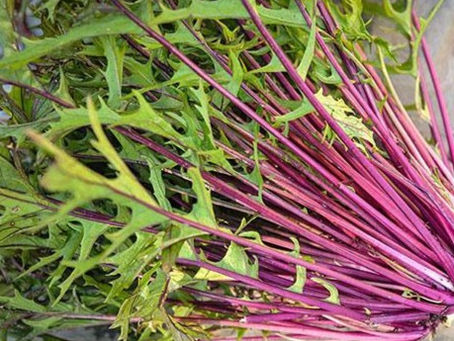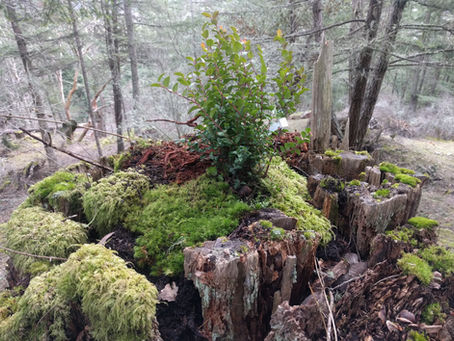top of page

pendragon orchard and vine
Turning Landscape into Legacy
Blog
Subscribe for writing that turns landscapes into legacies
Search


Defiance, Part I: The Last Apple Standing
I love this apple for its defiance. It’s the ultimate winter keeper apple. It is also one of the most balanced apples I’ve had—sweet, acidic, and without the penalty that plagues so many late hangers. The skin isn’t that tough, battlefield-leather armor you get with other winter apples. It’s firm, yes, but fair. The history, its endurance, though, makes it worth having.
Wolfy
12 hours ago4 min read


Defensive Design: How to Build Edible Landscapes That Survive Reality
It’s the classic social-media reflex: someone posts a leaf with a wrinkle, and five seconds later a stranger hollers leaf curl! as if pronouncing a curse.
Wolfy
4 days ago7 min read


Winter Garden: What My Grandfather’s War Garden Still Teaches Me - Part 2
They understood that certain transformations only happen slowly, in the cold. That winter isn’t an obstacle but a collaborator. That time itself is a tool, if you know how to wield it. Most modern people try to fight winter. Japan fermented it.
Wolfy
7 days ago7 min read


Winter Garden: What My Grandfather’s War Garden Still Teaches Me
Before sunrise, I walk the wind-cut rows of my winter garden on Orcas, gathering lettuce, kale, and collards for breakfast. As frost clings to the leaves, I’m reminded of my grandfather’s wartime garden—how his acre kept neighbors alive when winter meant scarcity, not inconvenience. That memory becomes a doorway into older worlds where people survived the cold without refrigerators, grocery stores, or modern rescue.
Wolfy
Nov 136 min read


From Soil to Cell: How Nutrient-Dense Gardens and Landscapes Rebuild Human Resilience
The first act of cultivation is not planting — it’s inquiry. Test the soil. Read its chemistry and its silence. Some soils are burdened — with metals, residues, or exhaustion from years of extraction. Others are simply asleep, waiting to be woken. You must know which you have before asking it to feed you.
Tamayo
Oct 287 min read


Designing Fragrant Gardens for the Pacific Northwest
For millennia, fragrance guided the design of gardens — from Persian courtyards to monastic cloisters. Today it’s often missing. In the Pacific Northwest, restoring scent means designing with intimacy, ecology, and time.
Wolfy
Oct 74 min read


Gardening Bootcamp - 8 Beginning Mistakes That Will Cost You
From bad plant choices to nightly deer raids, here’s what sinks most first-time gardens.
Wolfy
Sep 83 min read


I'm Done Growing Annual Vegetables: An Elegy for Classic Gardening and Landscape Design
I love vegetables. I love to eat them. I’ve eaten them on porches and back steps, under summer light and winter cloud. I’ve pulled them from soil I amended by hand. I’ve bent to weed them in heat that wrung the salt from my skin. And still—I don’t grow annuals. Mix of annual and perennial vegetables in the OCS garden. Zone 8b. Pacific Northwest gardening at its best. As a permaculture designer, I’m often asked to build out classic vegetable beds for clients. And I do, becaus
Wolfy
Jul 123 min read


Subscribe to Discover the Top 10 "Permaculture" Species: A Must-Read Series for all Gardeners.
Are you ready to delve into the fascinating world of permaculture and explore the top 10 species that can transform your sustainable gardening and farming practices? We're excited to announce that Pendragon Permaculture is embarking on an insightful journey, publishing a curated list of the most impactful permaculture species that every nature enthusiast, gardener, and eco-conscious individual should know about. Starting this month, we'll be unveiling a series of articles tha
Wolfy
Aug 16, 20231 min read


Winter Gardening Made Easy
It came upon us fast here in the Maritime Northwest: winter! Not the season, but the time to plan our fall and winter garden. That happens now, in July and August, at the height of summer, as part of a four-season gardening strategy. Gardening in the fall can be just as productive and enjoyable as summer...and easier. To start, you won't be pulling as many weeds as in spring and summer, and the ground will be much softer, so working the dirt and pulling any weeds won't be as
Wolfy
Aug 8, 20235 min read


Peppers in June? Easy, They're Perennial
Here in the Maritime Northwest there are several reliable pepper varieties we can grow without climate hacking. These mostly produce fruit that are lower on the Scoville scale, as higher, generally, requires more heat units than we can offer in our local ecology without a greenhouse. While appropriate variety selection is important, you can be most successful growing peppers by planning to grow them as perennials and not annuals. Jump Start It’s June, and my first peppers, S
Wolfy
Jun 20, 20211 min read


Easy, Fresh Greens in Winter: A Guide to Maritime Northwest Winter Gardening
Wondering how to feed yourself fresh greens, berries, and fruit in the maritime northwest winter without a greenhouse or a trip to the grocery store? It's not hard; it's about appropriate species and variety selection. Our maritime climate is kind to us gardeners, and we should give thanks by growing all year long, especially in winter when food is scarce. There are less pests to worry about in winter too, and no watering. Below are some of the species and varieties that are
Wolfy
Dec 19, 20204 min read


Four Season PNW Gardening: Planting in April - Part 2
Part II: Apiaceae (Carrot Family) Carrot family members are, generally, cool-season cultivated and may not grow when the soil gets too warm. They are widely accepted as excellent companion plants due to their flowers clustered into umbels that are well suited habitat for ladybugs , parasitic wasps , and predatory flies , which prey upon insect pests on nearby plants. Members of this family that produce scents may mask the odor of nearby plants and make them more difficult for
Wolfy
Apr 11, 20201 min read


Four Season PNW Gardening: What Do I Plant Now?
Part I: Solanaceae (Nightshades), Chenopodiaceae (Beet Family), Compositae (Sunflower) You may have noticed the calendar says April, though your skin may not be in agreement with the calendar. Don’t be fooled by the colder than average temps: you already need to be knee deep in growing food, just as you do every month of the year in the PNW. Why? Because you can and should be growing or harvesting food here all year around. This is a blessed four season growing/harvesting
Wolfy
Apr 4, 20202 min read


Permaculture Gardening and Landscaping: Using Stumps to Grow Native Food
On a recent Orcas Island project, we found an opportunity to grow food and restore PNW natives without deer fencing. For those of you with property that has a history of logging, you may find old, rotted conifer stumps shoulder height or greater. These are natural "planters" for Red Huckleberry, among other species, like salal, in the forests of the PNW that deer can't reach. Rotting stumps act as a sponge, storing rainwater that is critical for huckleberry survival in summer
Wolfy
Mar 21, 20191 min read
bottom of page